‘One of Suffolk’s Best Kept Secrets’- Gainsborough’s House, Sudbury
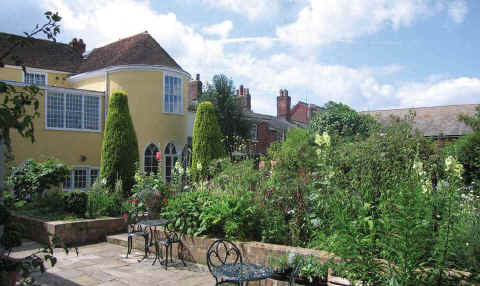
View of Back of Gainsborough’s House.
Sudbury is a somewhat unassuming market town, not quite on the tourist trail yet to those who have successfully ‘discovered’ it, a place of great charm, historic interest and picturesque beauty. It is encircled by the River Stour and open water meadows and common lands, where cattle graze and come to the water to drink – reminiscent, in fact, of a Gainsborough landscape painting.
In the centre of Sudbury, at 46 Gainsborough Street, is a Museum that has been described as ‘one of Suffolk’s best kept secrets’. For like the town itself, Gainsborough’s House is not grand or imposing but is a modest, attractive town house, tucked away amidst shops, restaurants, houses and offices.
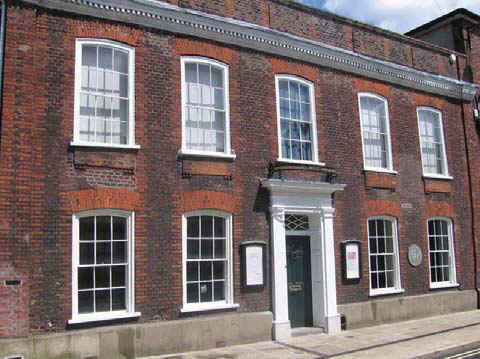
Façade of Gainsborough’s House.
Gainsborough’s House is the birthplace of Thomas Gainsborough (1727–1788), one of the greatest painters in the history of British art. It is the only Museum in Britain devoted to a single artist that occupies the place where they were born. More of Gainsborough’s paintings, drawings and prints are on display at any one time than anywhere else in the world. For while the National Gallery, the Tate or British Museum may have larger collections in terms of numbers of works by the artist, only a small proportion, if any, will be on public display.
The outstanding collection of Gainsborough’s work in Sudbury encompasses the artist’s whole career though, understandably, the Museum has particularly good examples of his early portraits or landscapes painted in Suffolk in the 1750s, while he was living in Sudbury and later in Ipswich until 1758. Amongst these is the recently acquired portrait of John Vere (c.1753), a member of the local landed gentry, whose open and direct gaze is similar to that of another early patron and local landowner, Robert Andrews, from Bulmer. The portrait of Mr and Mrs Andrews (c.1750) in the National Gallery is regarded as Gainsborough’s early masterpiece and an iconic work of the period. The permanent collection is augmented by several loans of paintings by Gainsborough or his contemporaries, from public and private collections. The Pitminster Boy, on long loan from a private collection, was probably one of the paintings that Gainsborough exhibited at the very first Royal Academy exhibition in London in 1769.
Gainsborough was also a superb draughtsman and produced hundreds or drawings throughout his life, using a wide range of different techniques. The Museum has an unrivalled collection of drawings. They are shown in regular exhibitions and, when not on display, are housed in a new Study Gallery, alongside prints, rare books and Gainsborough ephemera. Here, visitors can view a selection of works on paper and can have access to all works in the collection by appointment.
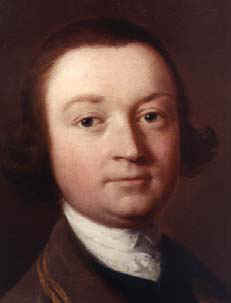 |
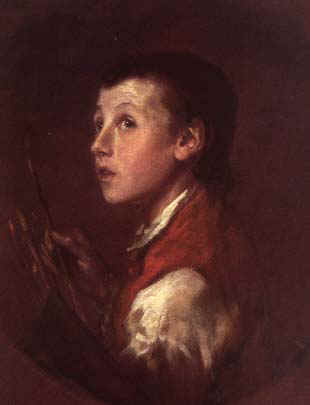 |
| John Vere. | The Pitminster Boy. |
Artists close to Gainsborough are also represented in the main galleries, such as his nephew and studio assistant Gainsborough Dupont (1754-1797), and those who were teachers or followers. A fascinating collection of Gainsborough memorabilia is displayed in the Entrance Hall, and includes the artist’s studio cabinet, his swordstick, paint scraper and pocket-watch.
The collection at Gainsborough’s House is particularly remarkable in that it has been acquired in a relatively short period, and with very limited funds. 2008 marks the fiftieth anniversary of the establishment of Gainsborough’s House Society as an independent charity with educational aims, which in 1958 bought the house in order to open it as a Museum and monument to Gainsborough. The Museum opened to the public in 1961. An exhibition, Gainsborough’s House: A Golden Celebration, runs from 29 March – 7 June. It explores the history of the House, from its life as a hotel and tea-room prior to its sale, the successful public appeal to buy it, the completion of the major restoration project in 2006, to the present. The story is told with photographs, paintings, drawings and archival material. The display also includes new works by artists specially invited to respond to this important historic building.
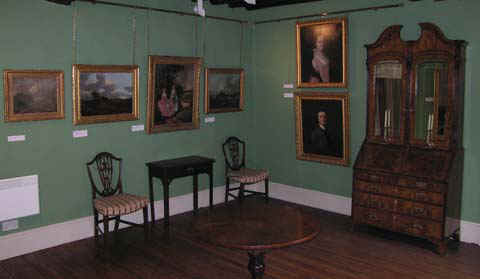
Parlour.
The exhibition programme at Gainsborough’s House is central to the Museum’s activities and it is one of the few venues in the region where people can see high quality exhibitions of both historic British art and contemporary art. Other exhibitions in 2008, for example, are of John Bellany, RA, one of the best-known and influential Scottish artists working today, followed in October by From Sickert to Gertler: Modern British Art from Boxted House, which has been organised by the National Galleries of Scotland, Edinburgh. This exhibition is a selection of works from the collection of Bobby Bevan, son of the Camden Town artist Robert Bevan, and his wife Natalie. It will include works by John Nash, Cedric Morris, Mark Gertler and Camden Town artists, such as Bevan, Walter Sickert and Spencer Gore.
Prints and printmaking are important and highly relevant themes for exhibitions at Gainsborough’s House as the Museum is unique in having its own Print Workshop neighbouring the House and opening out on to the beautiful garden with its ancient mulberry tree. Established by printmakers in 1978, the Print Workshop is a professional studio that is recognised as one of the best facilities of its kind in the country. A programme of classes, intensive summer courses and workshops for community and educational groups runs throughout the year and artists can join the Print Workshop as Members.
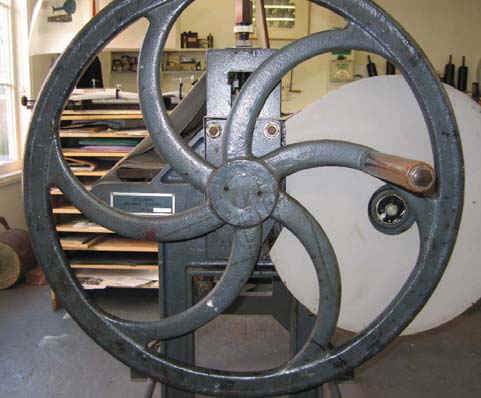
Close-up of Wheel Press in the Print Workshop.
The Museum has also recently established a lively Education and Outreach programme, aimed at both adults and children. The adjacent cottages on Weavers Lane were converted to enhance the Museum in 2003-4 by providing a new Entrance for visitors and an Education Centre upstairs, which has proved ideal for both lectures and classes as well as for social events. The Education Officer organises a wide variety of workshops and guided tours for schools, community groups and parties of visitors from the region and beyond. During school holidays, various events are run for children and families and there are also regular classes on offer, such as Artsmart, a Saturday morning art class for children, and a monthly Life Drawing session for adults. Art history lectures and gallery talks are programmed throughout the year, often to coincide with the current exhibition. The 14 Education Officer also runs Outreach sessions to schools, local art societies and other community groups to give talks on Gainsborough or other topics on request.
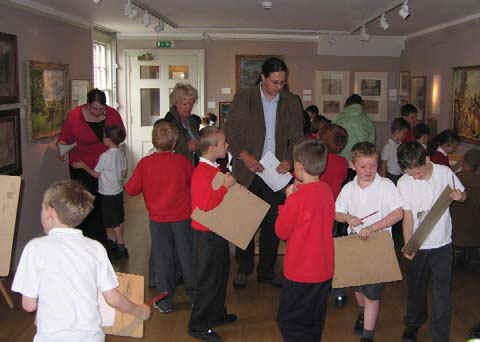
St. Gregory’s School Children.
The new Education programme was established alongside the recent major project to completely renovate the House and garden. The project, supported by a grant from the Heritage Lottery Fund and with donations from numerous other trusts, foundations and individual donors, began in 2005 and was successfully completed in 2007. The building renovation included some major structural improvements, the installation of a lift, new lighting and heating systems, complete redecoration of the House and the creation of a new Study Gallery and Entrance. The improvements have greatly enhanced the appearance of the House and its access for visitors but were also essential for the long-term security of the building and its collection. The installation of fire insulation, improved environmental controls and excellent storage facilities mean that the Museum is better able to care for its precious collection and provide the necessary modern conditions for loans.
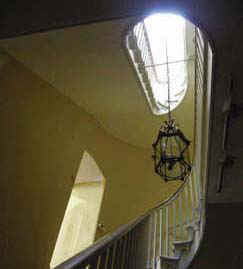
Interior View of the Staircase.
With only a small staff team, Gainsborough’s House is supported by numerous volunteers to help as room stewards in the House or to assist in the Coffee Shop or garden. As an independent charity, the organisation relies for its income on donations, grants, admissions and revenue from its Gift Shop and Coffee Shop. Museum funds are also raised by the Friends of Gainsborough’s House and its Patrons organisation. These groups of supporters benefit from lively programmes of trips, talks and other social events. Gainsborough’s House is always keen to recruit new Members and anyone interested in becoming a Volunteer, Friend or Patron, should contact Gainsborough’s House for further details.
While Gainsborough’s House is proud of the many favourable comments it receives from visitors, the Museum would prefer not to be ‘one of Suffolk’s best kept secrets’, as we are often referred to, but rather one of the region’s best-known Museums. With its wonderful collection of works by Thomas Gainsborough in the beautifully – renovated building and with its busy programme of exhibitions and education activities, we look forward to welcoming an increasing number of visitors from the region and beyond. Perhaps they could enhance a visit to the Museum with a walk by the River Stour to see the cattle grazing by the water and witness a Gainsborough tableau viivant in the heart of Sudbury.
DIANE PERKINS
Director

Cavendish Morton View of Gainsborough’s House, 1971.
Further Details
Open: Monday to Saturday 10am – 5pm
Closed: Sundays (including Bank Holiday Sundays),
Good Friday and from
24 December to 2 January
